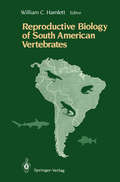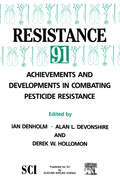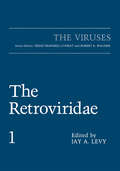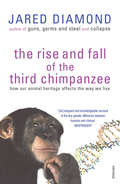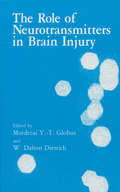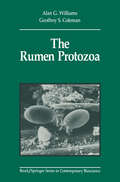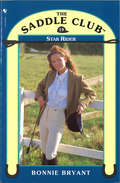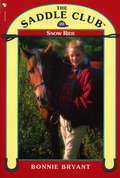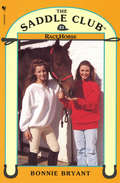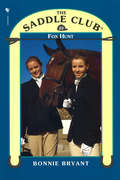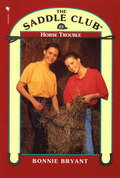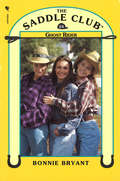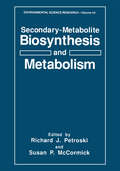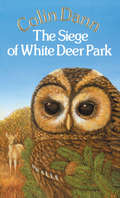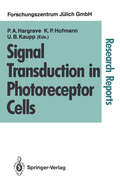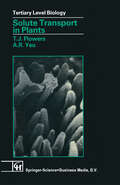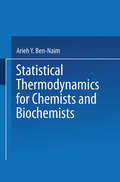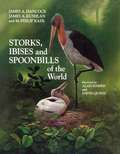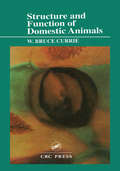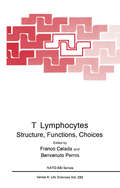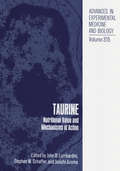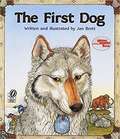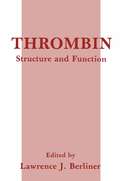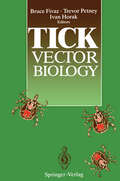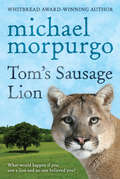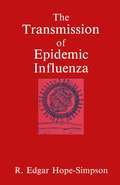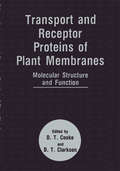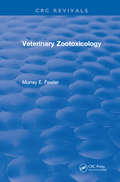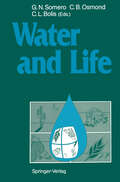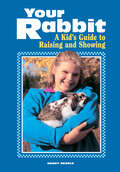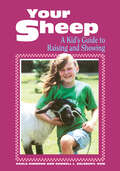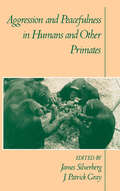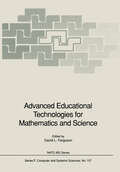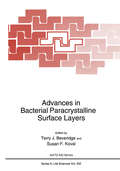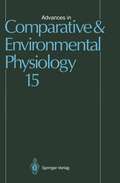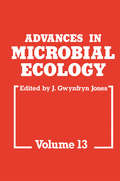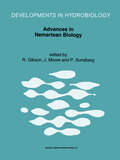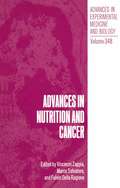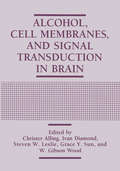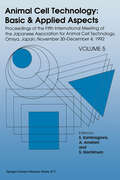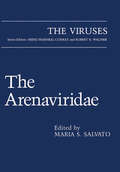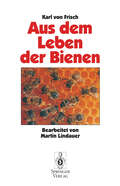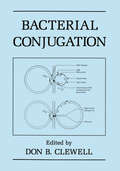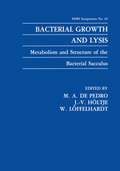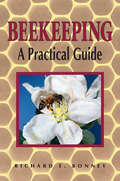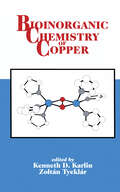Reproductive Biology of South American Vertebrates
by William C. HamlettSouth America is one of the few areas of the world that includes vast areas of as yet undisturbed natural habitats. These areas are home to as many as half the world's species of plants and animals. Many of the animals inhabit ing these areas are of direct and immediate economic importance, while others are of unknown potential value. With economic development of these areas, there is a coincident disruption of natural habitats that have a direct impact on the reproductive capabilities of the affected species. Re production is central to the survival of all species and, regardless of the environmental stresses imposed on them, scientific attention must be fo cused on reproductive biology as a way to deal with these pressures. It is vitally important to gather as much research data as possible on the repro ductive biology of the species on this continent in order to provide gov ernmental agencies and scientists with the most accurate information on which to base decisions regarding development. This volume is intended to draw attention to these pressing matters by gathering a wide representation of scientists actively engaged in reproduction research relating to South American vertebrates. It is intended that this volume will serve as a re source for individuals and organizations interested in reproductive biology and species survival. An additional benefit is that economically important species, as well as potentially important ones such as sharks, will be dis cussed.
Resistance’ 91: Achievements and Developments in Combating Pesticide Resistance
by I. Denholm A. Devonshire D. HollomonThe development of pesticide resistance in arthropod pests, plant pathogens and weeds can be viewed and studied from two contrasting perspectives. At a fundamental level, resistance provides an almost ideal example of adaptation to withstand severe environmental stress. Population geneticists, biochemists and, most recently, molecular biologists have cast considerable light on the nature of this adaptation in diverse taxonomic groups, and on factors determining its selection and spread within and between populations. Unlike most evolutionary phenomena, however, resistance is also of immediate practical and economic significance. Not only has the number of resistant species continued to increase inexorably, but there has been an alarming increase in the severity and extent of some resistance problems. Cases of organisms resisting virtually all available pesticides are by no means uncommon, and pose a formidable challenge in view of present difficulties in discovering and developing novel chemicals. Although most occurrences of resistance were initially monofactorial, resistance now frequently involves a suite of coexisting mechanisms that protect organisms against the same or different pesticide groups, and may even predispose them to resist new, as yet unused chemicals.
The Retroviridae (The Viruses)
by Jay A. LevyProviding both historical background and recent advances, this series reviews in-depth the biologic, molecular, immunologic, and patholic features of this facinating virus family. The current volume focuses on the avian and murine species which have generated novel insights into cancer, and the evolution of the retroviridae.
The Rise And Fall Of The Third Chimpanzee: How Our Animal Heritage Affects The Way We Live
by Jared DiamondMore than 98 percent of human genes are shared with two species of chimpanzee. The 'third' chimpanzee is man. Jared Diamond surveys out life-cycle, culture, sexuality and destructive urges both towards ourselves and the planet to explore the ways in which we are uniquely human yet still influenced by our animal origins.
The Role of Neurotransmitters in Brain Injury
by W. D. Dietrich M. Y. T. GlobusNeuroscientists from various disciplines have given extraordinary attention to the role of neurotransmitters in the field of neuronal injury. This volume summarizes the original oral and poster contributions which were presented at the symposium, "The Role of Neurotransmitters in Brain Injury," in Key West, Florida, between June 7-9, 1991. This symposium was the official Satellite of Brain-91, the Fifteenth International Symposium on Cerebral Blood Flow and Metabolism, held in Miami the previous week. The two principal goals of the Key West satellite meeting were to document recent progress and, more importantly, to explore future directions for investigative studies of the role of neurotransmitters in brain injury. To achieve these goals we assembled participants from diverse scientific fields and specialties who brought their collective expertise to discussions on the importance of neurotransmitters in neuronal and vascular injury following brain ischemia, trauma, and epilepsy. Their contributions are reflected in this volume. An important section of this volume is devoted to the role of glutamate and glutamatergic receptors in the development of ischemic neuronal damage. Topics covered include the mechanisms of glutamate and other excitatory amino acids, and the role of underlying injury-induced release different glutamatergic receptors in brain injury, including the NMDA and the non-NMDA receptors. The involvement of other neurotransmitters in the process of ischemic brain injury is well established.
The Rumen Protozoa (Brock Springer Series in Contemporary Bioscience)
by Alan G. Williams Geoffrey S. ColemanAll ruminants are dependent on the microorganisms that live in their forestomach - the rumen - to break down ingested feed constituents into a form that the host animal can utilize. Protozoa are part of this complex ruminal population and are essential for the nutritional well-being and productivity of the host ruminant. Over 30 different genera (nearly 300 species) of protozoa from the rumen ecosystem have been described since their initial discovery nearly 150 years ago. This book brings together, for the first time, the available information on these protozoa. It comprehensively describes the characteristic anatomical features of value for their identification and includes detailed sections on techniques and methodologies for the isolation and cultivation of these fastidious, oxygen-sensitive microorganisms. Their occurrence, biochemistry, physiology, and role in the ruminal ecosystem are fully reviewed. Particular emphasis is given to potential improvement of the nutrition and productivity of the host ruminant through manipulation of the protozoal population and its activities.
Saddle Club Book 19: Saddle Club Bindup 10 (The\saddle Club Bindup Ser. #No. 10)
by Bonnie BryantLisa, Carole and Stevie can’t believe their luck: Skye Ransom, the teen idol the Saddle Club met on their trip to New York City, is about to star on a new movie – and he wants the girls to help him with his riding! It’s a dream come true, especially when the director casts Lisa in a small part. But then Lisa discovers how lonely the life of a star can be, and Carole and Stevie realize how much they need their best friend’s help with plans for Carole’s father’s birthday. Will the Saddle Club manage to arrange a big birthday celebration and help Skye overcome his fear of horses?
Saddle Club Book 20: Saddle Club Bindup 10 (The\saddle Club Bindup Ser. #No. 10)
by Bonnie BryantSaddle up for some more great riding with the girls of Pine Hollow!Stevie's friend Dinah has invited her to go sugaring in Vermont! She is ready for riding and is determined to help Dinah win the sugar off competition. The winning team gets the first pick of horses for the summer. All is well until Dinah gets hurt, and she makes Stevie promise not to tell...
Saddle Club Book 21: Race Horse (The\saddle Club Bindup Ser. #No. 35)
by Bonnie BryantWhen Carole discovers that her horse Starlight has a slight injury, she’s disappointed at having to spend the next two weeks without a mount. But Judy, a local veterinarian, has an idea: Carole can spend her time with dozens of horses, helping Judy out after school and at the weekends. Carole jumps at the chance, especially since among Judy’s ‘patients’ are some magnificent racehorses. What could be more exciting than working with a stable full of beautiful thoroughbreds?But Carole soon learns that caring for racehorses isn’t all fun. During a race, a horse named Prancer is badly injured, and she’ll never compete again. When Prancer’s owner immediately decides to sell her, Carole is horrified. Can she and the rest of The Saddle Clun find a new home for the beautiful racehorse?
Saddle Club Book 22: Saddle Club Bindup 11 (The\saddle Club Bindup Ser. #Vol. 11)
by Bonnie BryantThe Saddle Club girls are in for some real excitement when Stevie’s boyfriend Phil invites them – along with a few other kids from their Pony Club – to participate in a genuine fox hunt. Stevie, Lisa and Carole can’t wait for the event to begin, especially when they find out that no harm will come to the fox. But first, to give everyone a chance to learn the ropes, there’s a mock hunt in Pine Hollow Stables. As the most devious of the bunch, Stevie is chosen to play the fox. On the day of the hunt, she finds she isn’t the only one who’s devious… when her prank-playing brothers get involved in the chase!
Saddle Club Book 23: Saddle Club Bindup 12 (The\saddle Club Bindup Ser. #Vol. 12)
by Bonnie BryantWhen Mrs. Reg, the manager of Pine Hollow Stables, goes away for a few days, The Saddle Club is determined to pitch in and keep things running smoothly. Lisa, Carole and Stevie decide they know everything there is to know about horses, so they’ll have no problem managing a stable for a few days… right? Wrong! Instead it seems that every time the girls try to help, disaster quickly follows. More paint winds up on one of the horses than on the stable; several riders don’t get quite the ride that they expect; and Mrs. Reg’s paperwork is in utter chaos. Soon the members of The Saddle Club are wondering if being horse crazy is enough to manage a stable, after all!
Saddle Club Book 24: Ghost Rider
by Bonnie BryantWhen Lisa, Carole and Stevie head west to the Bar None Ranch, they have a great time planning a Halloween party with their friends Kate and John, a Native American boy who works on the ranch. The Saddle Club is also thrilled when they get the chance to see a herd of wild horses, including the beautiful grey stallion that Kate wants to adopt. Then John tells the girls a mysterious Indian legend about a grey stallion, and warns Kate to keep her distance from the one in the herd. Is John just playing a Halloween trick or is Kate about to ride into danger? The Saddle Club is about to find out!
SCHOOL EXERCISES FOR FLATWORK AND JUMPING: A Handbook For Instructors And Riders
by ELEANOR ROSSThis volume offers ideas and specimen exercises for trainee instructors and more experienced instructors, and for riders schooling their own horses or ponies, and aims to provide purpose, variety and interest to lessons and riding sessions, for teachers, horses and riders.
Secondary-Metabolite Biosynthesis and Metabolism (Environmental Science Research #44)
by Richard J. Petroski Susan P. McCormickThis book was developed from the proceedings of the American Chemical Society, Division of Agricultural & Food Chemistry, subdivision of Natural Products Symposium "Biosynthesis and Metabolism of Secondary Natural Products" held in Atlanta, Georgia, April 1991. The objective of the conference was to bring together people from apparently diverse fields, ranging from biotechnology, metabolism, mechanistic organic chemistry, enzymology, fermentation, and biosynthesis, but who share a common interest in either the biosynthesis or the metabolism of natural products. It is our intention to help bridge the gap between the fields of mechanistic bio-organic chemistry and biotechnology. Our thanks go to Dr. Henry Yokoyama, co-organizer of the symposium, the authors who so kindly contributed chapters, the conference participants, and to those who assisted in the peer review process. We also thank the financial supporters of the symposium: ACS/AGFD, NIH General Medical Sciences, and the agricultural, pharmaceutical, biotechnology, and chromatography companies. A full list of the supporting corporations and institutions is given on the following page. Pharma-Tech and P.C., Inc. are manufacturers of instrumentation for high-speed countercurrent chromatography. We thank the Agricultural Research Service and the U. S. Department of Agriculture for granting me permission to co-organize the conference and for us to complete the book. Richard J. Petroski Susan P. McCormick USDA, ARS, National Center for Agricultural Utilization Research Peoria, IL 61604 June 10, 1992 vii CONTENTS ANTIBIOTICS Polyketide Synthetases: Enzyme Complexes and Multifunctional Proteins Directing the Biosynthesis of Bacterial Metabolites from Fatty Acids. . . . . . . . . . . . . . . . . . . . . . . . . . . . . . . 3 . . . . . . . . . . .
The Siege Of White Deer Park (The\farthing Wood Ser. #Vol. 5)
by Colin DannTerror has come to White Deer Park, driving panic-stricken animals before it. A killer beast is on the loose - a predator so silent and skillful that it leaves almost no trace, and has never been seen.As the deaths mount up, Owl, Fox, Badger and the elders of Farthing Wood meet to make a plan. They have fought tough corners before; have they now, finally, met their match?
Signal Transduction in Photoreceptor Cells: Proceedings of an International Workshop Held at the Research Centre Jülich, Jülich, Fed. Rep. of Germany, 8–11 August 1990 (Research Reports in Physics)
by Paul A. Hargrave Klaus P. Hofmann U. Benjamin KauppThis book deals with the mechanism of signal transduction in vertebrate and invertebrate photoreceptors. It contains contributions on the structure and function of rhodopsin or other G-coupled receptors, on the regulation of second messengers by enzyme cascade, the role of Ca2+ in light adaptation, control of ionic channels in photoreceptor cells.
Solute Transport in Plants (Tertiary Level Biology Ser.)
by T.J. Flowers A.R. YeoThe study of solute transport in plants dates back to the beginnings of experimental plant physiology, but has its origins in the much earlier interests of humankind in agriculture. Given this lineage, it is not surprising that there have been many books on the transport of solutes in plants; texts on the closely related subject of mineral nutrition also commonly address the topic of ion transport. Why another book? Well, physiologists continue to make new discoveries. Particularly pertinent is the characterisation of enzymes that are able to transport protons across membranes during the hydrolysis of energy-rich bonds. These enzymes, which include the H + -A TPases, are now known to be crucial for solute transport in plants and we have given them due emphasis. From an academic point of view, the transport systems in plants are now appreciated as worthy of study in their own right-not just as an extension of those systems already much more widely investigated in animals. From a wider perspective, understanding solute transport in plants is fundamental to understanding plants and the extent to which they can be manipulated for agricultural purposes. As physiologists interested in the mechanisms of transport, we first set out in this book to examine the solutes in plants and where are they located. Our next consideration was to provide the tools by which solute movement can be understood: a vital part of this was to describe membranes and those enzymes catalysing transport.
Statistical Thermodynamics for Chemists and Biochemists
by Arieh Y. Ben-NaimThis book was planned and written with one central goal in mind: to demonstrate that statistical thermodynamics can be used successfully by a broad group of scientists, ranging from chemists through biochemists to biologists, who are not and do not intend to become specialists in statistical thermodynamics. The book is addressed mainly to gradu ate students and research scientists interested in designing experiments the results of which may be interpreted at the molecular level, or in interpreting such experimental results. It is not addressed to those who intend to practice statistical thermodynamics per se. With this goal in mind, I have expended a great deal of effort to make the book clear, readable, and, I hope, enjoyable. This does not necessarily mean that the book as a whole is easy to read. The first four chapters are very detailed. The last four become progressively more difficult to read, for several reasons. First, presuming that the reader has already acquired familiarity with the methods and arguments presented in the first part, I felt that similar arguments could be skipped later on, leaving the details to be filled in by the reader. Second, the systems themselves become progressively more com plicated as we proceed toward the last chapter.
Storks, Ibises and Spoonbills of the World (Helm Identification Guides)
by James Hancock James A. Kushlan M. Philip Kahl Alan Harris David QuinnEverything you ever wanted to know about storks, ibises and spoonbills.
Structure and Function of Domestic Animals
by W. Bruce CurrieStructure and Function of Domestic Animals provides a solid introduction to the functional anatomy of domestic animals. The author covers general principles, phenomena, and mechanisms and then supports this information by providing concrete examples, giving you a working understanding of the biology of animals. Line drawings, tables, and text boxes provide supplemental information. The author examines the functions of animals from the basic to the complex. The pragmatic application of these principles allows for the raising and caring for animals with the appropriate regard for their welfare. He covers morphology, myology, electrophysiology, endocrinology, comparative anatomy, metabolism, cell growth and development, and reproductive mechanisms. The mechanism and phenomena described in this book will introduce you to the flexibility or plasticity of normal animal function. The author's pedagogical writing style clearly delineates normal function and abnormal function. Structure and Function of Domestic Animals explores many of the seemingly endless examples of the ways in which animals apply the fundamental principles of chemistry and physics to preserve their integrity. It gives you an insightful overview to a very broad subject.
Structure and Function of Domestic Animals
by W. Bruce CurrieStructure and Function of Domestic Animals provides a solid introduction to the functional anatomy of domestic animals. The author covers general principles, phenomena, and mechanisms and then supports this information by providing concrete examples, giving you a working understanding of the biology of animals. Line drawings, tables, and text boxes provide supplemental information. The author examines the functions of animals from the basic to the complex. The pragmatic application of these principles allows for the raising and caring for animals with the appropriate regard for their welfare. He covers morphology, myology, electrophysiology, endocrinology, comparative anatomy, metabolism, cell growth and development, and reproductive mechanisms. The mechanism and phenomena described in this book will introduce you to the flexibility or plasticity of normal animal function. The author's pedagogical writing style clearly delineates normal function and abnormal function. Structure and Function of Domestic Animals explores many of the seemingly endless examples of the ways in which animals apply the fundamental principles of chemistry and physics to preserve their integrity. It gives you an insightful overview to a very broad subject.
T Lymphocytes: Structure, Functions, Choices (Nato Science Series A: #233)
by Franco Celada Benventuto PernisThis volume contains the proceedings of the NATO Advanced Study Institute held in Porto Conte (Alghero), Sardinia, September 15-27, 1991. The A. S. 1. was attended by 86 graduate and postgraduate students from 18 different countries, and was hosted by the newly founded International Laboratory of Molecular Genetics of Porto Conte, directed by Prof. Marcello Siniscalco. The A. S. I. was funded by NATO Scientific Affairs Division, the International Union of Immunological Societies, the European Community (Directorate General for Science, Research and Development), the Italian Research Council, and the San Raffaele Institute of Milano. In addition, a number of students who reside in the U. S. received travel funds from the U. S. National Science Foundation, and the Turkish National Fund provided financial assistance to several students from Turkey. When we decided to organize a course on T lymphocytes, our concern was to reach a balance between the teaching of both the hard core principles and the latest experimental findings of cellular immunology, and the recently expanded interfaces with the not-yet known: hypotheses, speCUlations, new projections to be born from the discussions.
Taurine: Nutritional Value and Mechanisms of Action (Advances in Experimental Medicine and Biology #315)
by John B. Lombardini Stephen W. Schaffer Junichi AzumaThe underlying philosophy of these two symposia on taurine remains the same as all those that have been held previously: the best way to remain current in the subject matter is to talk directly with the investigators at the forefront of the field. Thus, we brought together some 50 individuals from 11 different countries who have keen interests and active research programs in the many-faceted areas of taurine research. The meetings were held on October 8-10, 1991, in an elegant setting in a resort area at Orange Beach, Alabama, approximately 50 miles outside of Mobile on the Gulf Coast. The meetings were programmed as two separate Symposia held sequentially. The first symposia on October 8 was devoted exclusively to taurine research in the cat, primarily in the area of nutrition, and entitled "The Waltham Symposium on Taurine and Cat Nutrition". The second symposia on October 9 and 10 was open to all fields of taurine research and was entitled "International Taurine Symposium: New Dimensions on its Mechanisms of Actions". If the philosophy of these meetings was to bring both experts and novices together in a discussion and presentation of current taurine research, then the major purpose of the Proceedings is to document the current research efforts and to present an objective summary of where the taurine field stands today and where the focus will be in the future.
the first dog
by Jan BrettKip the Cave Boy offers to share all his woolly rhino ribs if Paleowolf will use his keen nose, fine ears, and sharp eyes to keep Kip from being eaten up. When Paleowolf agrees with a bark and a wag of his tail, Kip names his new friend Dog.
Thrombin: Structure and Function
by Lawrence J. BerlinerResearch on thrombin structure and function has progressed significantly over the past three decades. We are continually discovering new functions f()r this enzyme in biology. Yet, until quite recently, a full, detailed, three dimensional picture of its structure was difficult to attain. We believe that this text represents a turning point and, more appropriately, a new start ing point for thrombin studies. Our goal for this text is to present a thorough and rounded-out coverage of thrombin chemistry and biochem istry in order to provide the biochemist and physiologist with an excellent desk reference on almost any thrombin-related problem. This volume is organized into three general thrombin topic areas: Structure, Biochemistry, and Physiology. In Part 1, Structure, we open with the complete three-dimensional x-ray structures of two inhibited human thrombin complexes, one of which is the thrombin-hirudin com plex. These complexes are also addressed in the chapter on structural studies in solution, which include NMR, ESR, and fluorescence. Part 2, Biochemistry, includes chapters on synthetic thrombin inhibitors, protein inhibitors (e.g., antithrombin III, hirudin), and thrombin interactions with factor XIII. Part 3, Physiology, covers such topics as chemotactic activities, interactions with cell surfaces, and the vascular endothelium.
Tick Vector Biology: Medical and Veterinary Aspects
by Bruce Fivaz Trevor Petney Ivan HorakThe book provides a comprehensive account of ticks and tick-borne diseases occurring in tropical and subtropical areas. It begins with a complete up-to-date overview of the systematics of the Ixodida (Ixodidae, Argasidae and Nutalliellidae) and is followed by a review of the problem of ticks and tick-borne diseases of domestic animals world wide. This leads on to multi-disciplinary approaches to planning tick and tick-borne disease control and to contributions on calculating the economic impact of a tick species such as Amblyomma americanum on beef production systems. Heartwater fever (cowdriosis) and dermatophilosis are endemic in Africa and pose a threat to the North American mainland. The epidemiology of these two diseases is discussed in detail as is the role of frozen vaccines to control bovine babesiosis and anaplasmosis. The book also includes chapters on tick transmitted zoonoses such as Lyme borreliosis, tick typhus and ehrlichiosis. It concludes with a review of the acaricidal treatment of tick infestation.
Tom's Sausage Lion
by Michael MorpurgoBut it's true,' Tom shouted. 'It was a real lion, I know it was.'No-one believes Tom when he says he has seen a lion - padding around the orchard with a string of sausages in its mouth! No-one, that is, except for Clare, the cleverest girl in the class. Together, she and Tom plan to prove his story is true - by catching the lion!
The Transmission of Epidemic Influenza
by R.E. Hope-SimpsonTHE PLAGUE YEARS Mankind has always been fascinated by "origins," and biologists are no exception. Darwin is our most famous example. What is the origin of mankind, of species, of infectious diseases? In the last few years we have seen the emergence and spread of some apparently "new" viruses, such as HIV -1 and the virus causing bovine spongiform encephalomyelopathy. But are these, in fact, entirely new agents, or mutated forms of "old" viruses that have evolved along with us for eons? Edgar Hope-Simpson could not have written this book at a more opportune moment. He is a firm believer in gradual evolution, rather than the sudden arrival of new agents. I suspect that he would also have a naturalist's Darwinian approach for the origin of AIDS. It has been a source of some amazement to me over the years how even the most innovative scientists conform to a current hypothesis. Pioneer thinking comes more easily to persons outside the scientific mainstream. Edgar Hope Simpson has always struck me as a modem-day naturalist of the classic style, observant and perhaps a little maverick in line of thought. Certainly, the central hypothesis propounded in this book will be controversial to many scientists. From his unique citadel, the Epidemiological Research Unit in Cirencester, he has carefully reexamined mortality data from old records as well as new.
Transport and Receptor Proteins of Plant Membranes: Molecular Structure and Function
by D. T. Clarkson D. T. CookeVeterinary Zootoxicology
by Murray E. FowlerOnly clinically oriented volume devoted to poisonous animals and venoms. Veterinary Zootoxicology provides an excellent overview of the state of the art in venom research. Clinical problems encountered in the United States are emphasized, but situations that occur in other areas of the world are examined as well. The book describes clinical syndromes caused by poisonous animals and provides facts, techniques, methodologies, and regimens designed to improve the clinical management of animals envenomated by other animals. Veterinary Zootoxicology is ideal for practicing veterinarians, students, instructors, wildlife biologists, and others who must know how to evaluate, diagnose, and treat envenomated animals.
Veterinary Zootoxicology
by Murray E. FowlerOnly clinically oriented volume devoted to poisonous animals and venoms. Veterinary Zootoxicology provides an excellent overview of the state of the art in venom research. Clinical problems encountered in the United States are emphasized, but situations that occur in other areas of the world are examined as well. The book describes clinical syndromes caused by poisonous animals and provides facts, techniques, methodologies, and regimens designed to improve the clinical management of animals envenomated by other animals. Veterinary Zootoxicology is ideal for practicing veterinarians, students, instructors, wildlife biologists, and others who must know how to evaluate, diagnose, and treat envenomated animals.
Water and Life: Comparative Analysis of Water Relationships at the Organismic, Cellular, and Molecular Levels
by George N. Somero Charles B. Osmond Carla L. BolisPresenting an analysis of the water relationships of the major groups of organisms: fungi, plants and animals, the text examines water stress at all levels of biological organization. Topics covered include: 1) organic osmotic agents: their distributions, modes of action, and mechanisms of regulation; 2) desiccation stress; mechanisms for preserving cellu lar integrity under conditions of low cellular water activity; 3) water stress and water compartmentation in plants; and 4) freezing stress: the prevention and regulation of ice formation in biological fluids, and mechanisms for overcoming the damaging effects of low temperatures on cellular integrity. Common adaptive strategies in diverse organisms are emphasized, as well as the fundamental physical-chemical properties of aqueous solutions that establish the nature of the interactions among water, low molecular weight solutes and macromolecules.
Your Rabbit: A Kid's Guide to Raising and Showing
by Nancy SearleDesigned for children ages 9 and up who are interested in raising rabbits, this comprehensive guide covers all aspects of rabbit care with an encouraging tone and age-appropriate language. Nancy Searle provides expert advice on breed selection, housing, feeding, safety, and understanding rabbit behavior. Whether your child is hoping to keep rabbits as pets or breed them for showing, Your Rabbit has everything she&’ll need to know to confidently raise happy and healthy animals.
Your Sheep: A Kid's Guide to Raising and Showing
by Paula Simmons Darrell L. SalsburyWhether you're getting your first sheep or would like to learn more about caring for and showing the sheep you have, Your Sheep has the information you need to be successful. Paula Simmons and Darrell Salsbury cover everything you need to know, from choosing and buying the right sheep to feeding, heath care, shearing, showing, breeding, and lambing.
Aggression and Peacefulness in Humans and Other Primates
by James Silverberg J. Patrick GrayThis book explores the role of aggression in primate social systems and its implications for human behavior. Many people look to primate studies to see if and how we might be able to predict violent behavior in humans, or ultimately to control war. Of particular interest in the study of primate aggression are questions such as: how do primates use aggression to maintain social organization; what are the costs of aggression; why do some primates avoid aggressive behavior altogether. Students and researchers in primatology, behavioral biology, anthropology, and psychology will read with interest as the editors and contributors to this book address these and other basic research questions about aggression. They bring new information to the topic as well as an integrated view of aggression that combines important evolutionary considerations with developmental, sociological and cultural perspectives.
Adaptation in Stochastic Environments (Lecture Notes in Biomathematics #98)
by Jin Yoshimura Colin W. ClarkThe classical theory of natural selection, as developed by Fisher, Haldane, and 'Wright, and their followers, is in a sense a statistical theory. By and large the classical theory assumes that the underlying environment in which evolution transpires is both constant and stable - the theory is in this sense deterministic. In reality, on the other hand, nature is almost always changing and unstable. We do not yet possess a complete theory of natural selection in stochastic environ ments. Perhaps it has been thought that such a theory is unimportant, or that it would be too difficult. Our own view is that the time is now ripe for the development of a probabilistic theory of natural selection. The present volume is an attempt to provide an elementary introduction to this probabilistic theory. Each author was asked to con tribute a simple, basic introduction to his or her specialty, including lively discussions and speculation. We hope that the book contributes further to the understanding of the roles of "Chance and Necessity" (Monod 1971) as integrated components of adaptation in nature.
Advanced Educational Technologies for Mathematics and Science (NATO ASI Subseries F: #107)
by David L. FergusonThis book is the outgrowth of a NATO Advanced Research Workshop, held in Milton Keynes (United Kingdom) in the summer of 1990. The workshop brought together about 30 world leaders in the use of advanced technologies in the teaching of mathematics and science. Many of these participants commented that the workshop was one of the more productive and exciting workshops that they had attended. It was not uncommon to see participants engaged in informal discussion far into the evenings and early mornings, long after formal sessions had ended. It is my hope that this book captures the substance and excitement of many of the ideas that were presented at the workshop. Indeed, the process by which this book has come about has given every opportunity for the best thinking to get reflected here. Participants wrote papers prior to the workshop. After the workshop, participants revised the papers at least once. In a few instances, three versions of papers were written. Some participants could not resist the urge to incorporate descriptions of some of the newer developments in their projects. The papers in this book demonstrate how technology is impacting our view of what should be taught, what can be taught, and how we should go about teaching in the various disciplines. As such, they offer great insight into the central issues of teaching and learning in a wide range of disciplines and across many grade levels (ranging from elementary school through undergraduate college education).
Advances in Bacterial Paracrystalline Surface Layers (Nato Science Series A: #252)
by Terry J. Beveridge Susan F. KovalThis book is a compilation of the research which was presented during the NATO-Advanced Research Workshop (ARW) entitled "Advances in Bacterial Paracrystalline Surface Layers" held in London, Ontario, Canada during September 27 to 30, 1992. The organizing committee consisted of the two Workshop directors, S. F. Kaval and T. J. Beveridge, and H. König, U. B. Sleytr and T. J. Trust; their summary statements about the significance and success of the NATO-ARWare in Chapter 37 of this book. This was the third international workshop on bacterial S-layers and it demonstrated unequivocally how rapidly research is progressing. The Workshop was made possible by financial support from the North Atlantic Treaty Organization (NATO), the Medical Research Council of Canada (MRC), the Natural Seiences and Engineering Research Council of Canada (NSERC), and the Canadian Bacterial Diseases Network (CBDN) which is a Canadian National Centre of Excellence (NCE). We are very grateful for the support from all of these agencies since their financial aid made it possible to bring to London, Canada a truly international group of S-layer experts. We encouraged the attendance and participation of graduate fellows and research associates, and their presentations students, postdoctoral was an intense three constitute the "Poster" section of this book. The NATO-ARW day workshop held at a delightful secluded location (Spencer Hall) so that the delegates had both formal and informal occasions to interact and evolve new ideas.
Advances in Comparative and Environmental Physiology: Volume 15 (Advances in Comparative and Environmental Physiology #15)
by G. F. Ball J. Balthazart M. Hidaka I. Novak M. WheatlyAdvances in Comparative and Environmental Physiology helps biologists, physiologists, and biochemists keep track of the extensive literature in the field. Providing comprehensive, integrated reviews and sound, critical, and provocative summaries, this series is a must for all active researchers in environmental and comparative physiology.
Advances in Microbial Ecology (Advances in Microbial Ecology #13)
by John Gwynfryn JonesKevin Marshall is a hard act to follow. Volume 13 of Advances in Microbial Ecology has been produced by a new editorial board, and we, the members of that board, are delighted to have the opportunity to pay tribute to Kevin's achievements. In his time as Series Editor, the quality of the chapters submitted and the range of subject matter covered have ensured an expanding and more stimulated readership. This represents a considerable achievement, given the growth in the number of review volumes and the increasing tendency for journals to publish review articles. The achievement was reached not only through metic ulous attention to quality and detail but also by providing a forum for the expression of views, information, and results that would stimulate discussion. Advances in Microbial Ecology will continue to provide such a focus, although, because of the frequency of publication, it would not be practicable to introduce a "reply" or "comment" section. Although we do not deliberately aim to provide a forum for controversy, we encourage speculation based on sound scientific arguments. In addition, we would like to encourage authors to offer chapters for consideration. In the past, the volumes have largely comprised invited chapters. With the best will in the world, an editorial board of four cannot claim adequate coverage of such a vast and rapidly developing research area. We would there fore welcome submission of outline plans for chapters, which should be sent to the Editor.
Advances in Nemertean Biology: Proceedings of the Third International Meeting on Nemertean Biology, Y Coleg Normal, Bangor, North Wales, August 10–15, 1991 (Developments in Hydrobiology #89)
by R. Gibson J. Moore Per LundbergIn any scientific discipline, meetings with presented papers and discussions are the most effective stimulus to the advancement of knowledge. Nemerteans have long been largely neglected because their taxonomy is difficult: the need for histological study of serial sections has proved inhibiting to most zoologists. During the last twenty years, however, this intriguing phylum has attracted the attention both of increasing numbers of taxonomists as well as of workers interested in many aspects of, for example, their ecology, evolution, physiology and fine structure. The enthusiam stemming from the First International Meeting held in Philadelphia during December 1983 made it abudantly clear that regular meetings of this type should be continued. The Second, at the Tjärnö Marine Biological Laboratory in Sweden (August 1986), emphasized the importance of such international gatherings. The Third Meeting was held in Britain, at Y Coleg Normal, Bangor, North Wales, August 10--15, 1991, with 24 participants from six countries. This volume records most of the papers given at the conference.
Advances in Nutrition and Cancer (Advances in Experimental Medicine and Biology #348)
by Vincenzo Zappia Marco Salvatore Fulvio Della RagioneThis volume contains the scientific contributions presented at the International Symposium held in Naples, Italy, in November 1992 at the National Tumor Institute "Fondazione Pascale". The Meeting gathered together experts from different disciplines, all involved in the vital and timely subject of Nutrition and Cancer. About 15 years ago a consensus among cancer epidemiologists began to emerge suggesting that diet might be responsible for 30-60% of the cancers in the developed world. The best estimate, reported in a now classical paper by Richard Doll and Richard Peto (1981), was that by dietary modification, it would be possible to reduce fatal cancers by about 35%. Within about six years there was widespread agreement that the principal changes required were a reduction in consumption of fat, along with an increase in the consumption of fruit, green and yellow vegetables, dietary fiber, and some micronutrients. Attention was also paid to the methods of cooking and preservation of foodstuffs. On the other hand very few, if any, effects were attributed to food additives and to pollution of food by trace pesticides, to which the general public often gives unfounded importance.
Alcohol, Cell Membranes, and Signal Transduction in Brain
by Christer Alling Ivan Diamond Steven W. Leslie Grace Y. Sun W. Gibson WoodAlcohol abuse and alcoholism are international problems whose costs economical ly, psychologically and medically have been well documented. Alcohol is a unique drug in that the effects of excessive use can have a deleterious effect on most if not all organs of the body. The brain is one of the organs most affected by excessive alcohol consumption. Effects on the brain can be seen in cognitive function, brain structure and neurochemistry. Over the past few years, there have been significant advances made in understanding how alcohol affects brain neurochemistry. This book examines four major areas, i. e. , membrane lipids, receptors and ion channels, second messengers, and gene expression, where significant advancements have been made. The book is divided into four sections based on the four major areas. In each section, data are examined that cover a range of approaches from in vitro to in vivo studies. The section on membrane lipids includes recent developments in how ethanol affects membrane cholesterol domains, polyunsaturated fatty acids, the cause and consequences of phosphatidylethanol formation, and the modulation of membrane protein function by lipid-protein interaction. The second section comprises chapters on NMDA and 5-HT3 receptors, including new aspects on alcohol neurotoxicity and the molecular heterogeneity that may underlie differences in alcohol sensitivity as well as chapters on GABA-gated chloride flux, and calcium channels.
Animal Cell Technology: Proceedings of the Fifth International Meeting of the Japanese Association for Animal Cell Technology, Omiya, Japan, November 30–December 4, 1992 (Animal Cell Technology: Basic & Applied Aspects #5)
by S. Kaminogawa A. Ametani S. HachimuraAnimal cell technology has been making tremendous progress. Originally this term reminded people of engineering for high density and large volume culture of animal cells. At present many fields of biological sciences are aiming at advance in animal cell technology. Cell culture engineering is aided not only with developments in apparatus, matrix, media, and computational analysis, but also with new biological procedures in gene and protein technology, cell biological resources and immunological methods. Results obtained with animal cell technology are applied to production of pharmaceuticals, diagnosis reagents and food endowed with physiological functions, and cell and gene therapy of animals and humans, and useful for elucidating scientific phenomena. It is also essential to establish methods of evaluation for functionality and safety of newly discovered molecules and cells. The progress in animal cell technology is supported by, and attributes in both of basic and applied sciences. The proceedings of the Fifth International Meeting of the Japanese Association for Animal Cell Technology (JAACT) covers the subjects above mentioned. The articles in this book will help researchers in many fields to understand the current status and future trends in animal cell technology. JAACT organized this Meeting and we express our gratitude to the members of JAACT. We gratefully acknowledge all the members of the organizing committee for their dedication in assuring the Meeting's success. For their valuable supports, we also thank the Japanese Biolndustry Association and Saitama Foundation for Culture and Industry.
The Arenaviridae (The Viruses)
by Maria S. SalvatoIn this volume, a distinguished international group of contributors present the latest molecular, organismal, and epidemiological research on arenaviruses. Their work will broaden both the clinician's and the researcher's knowledge of basic mechanisms of immunological tolerance, viral immunosuppression, the nature of protective immune responses to vaccination, and viral effects on cell functions.
Aus Dem Leben der Bienen
by Karl v. FrischDas berühmte Buch des Nobelpreisträgers Karl von Frisch liest sich wie eh und je leicht, einprägsam und flüssig.
Bacterial Conjugation
by D. B. ClewellBacterial plasmids originating in a wide range of genera are being studied from a variety of perspectives in hundreds of laboratories around the globe. These elements are well known for carrying "special" genes that confer important survival properties, frequently neces sary under atypical conditions. Classic examples of plasmid-borne genes are those provid ing bacterial resistance to toxic substances such as antibiotics, metal ions, and bacte riophage. Often included are those determining bacteriocins, which may give the bacterium an advantage in a highly competitive environment. Genes offering metabolic alternatives to the cell under nutritionally stressed conditions are also commonly found on plasmids, as are determinants important to colonization and pathogenesis. It is likely that in many, if not most, cases plasmids and their passenger determinants represent DNA acquired recently by their bacterial hosts, and it is the characteristic mobility of these elements that enables their efficient establishment in new bacterial cells by the process known as conjugation. Whereas many plasmids are fully capable of promoting their own conjugal transfer, others move only with help from coresident elements. The ability of a plasmid to establish itself in a variety of different species is com mon, and recent studies have shown that transfer can in some cases occur from bacterial cells to eukaryotes such as yeast.
Bacterial Growth and Lysis: Metabolism and Structure of the Bacterial Sacculus (F.E.M.S. Symposium Series #65)
by M. A. De Pedro J. V. Höltje Wolfgang LöffelhardtThis volume is based on a FEMS Symposium entitled "Bacterial Growth and Lysis: Metabolism and Structure of the Bacterial Sacculus" held at the Monastery of Lluc (Mallorca, Spain) on 5-10 April, 1992. The goals of the symposium were to assess the present state of knowledge on the structure and physiology of the bacterial murein sacculus, and to develop new hypotheses and strategies to promote further development of the field. Consequently, the contributions compiled in this volume include broadly different approaches, from the introduction of new analytical methods to the presentation of provocative models for cell wall growth and division. Structural, biochemical, and genetic aspects are widely covered with special emphasis on the enzymology and regulation of murein hydrolases (autolysins). Comprehensive reviews on bacterial S layers and yeast cell walls are included to stimulate conceptual cross-feeding with these closely related topics. We believe that this book will provide the reader with a useful and up-to-date review of the topic. We would feel deeply rewarded by any positive influence this book may have on the future progress of the field, whereby all the scientific credit for it should be given to the authors of the excellent contributions presented.
Beekeeping: A Practical Guide
by Richard E. BonneyKeep your own bees and enjoy delicious golden honey from your own backyard. With his respect and admiration for bees evident on every page, Richard E. Bonney describes how to acquire bees, manage a hive, prevent and treat diseases, and extract a crop of honey. Enthusiastic beekeepers of every stripe and experience level will benefit from Bonney&’s astonishing knowledge of the craft — from beekeeping history and honeybee biology to the complex social structure of the hive.
Bioinorganic Chemistry of Copper
by K.D. Karlin Z. TyeklarBioinorganic Chemistry of Copper focuses on the vital role of copper ions in biology, especially as an essential metalloenzyme cofactor. The book is highly interdisciplinary in its approach--the outstanding list of contributors includes coordination chemists, biochemists, biophysicists, and molecular biologists. Chapters are grouped into major areas of research interest in inorganic copper chemistry, spectroscopy, oxygen chemistry, biochemistry, and molecular biology. The book also discusses basic research of great potential importance to pharmaceutical scientists. This book is based on the first Johns Hopkins University Copper Symposium, held in August 1992. Researchers in chemistry, biochemistry, molecular biology, and medicinal chemistry will find it to be an essential reference on its subject.
